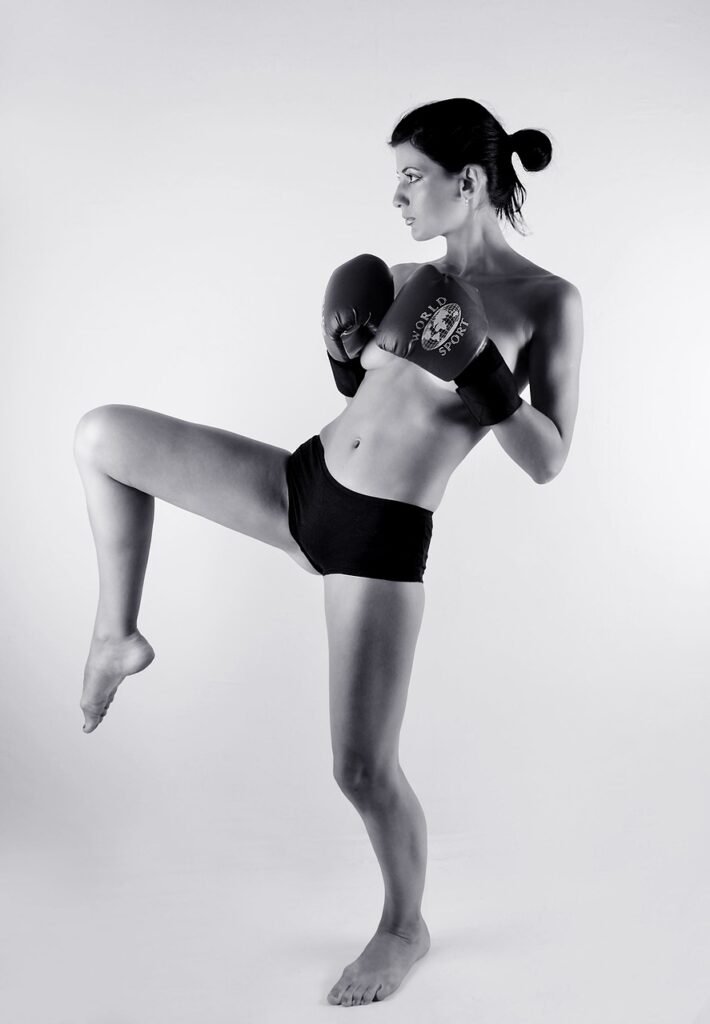In the world of mixed martial arts (MMA), mastering the ability to manage the distance between you and your opponent can be the key to victory. “Controlling Fight Ranges in MMA” dives into the essential techniques and strategies that help fighters dominate the various ranges of combat, from clinch work to striking at a distance. By understanding how to effectively control the fight range, you can increase your offensive capabilities while minimizing your opponent’s chances of landing significant strikes. Whether you’re a seasoned fighter or just stepping into the cage, this guide will enhance your skills and boost your confidence in controlling the pace and rhythm of any match. Have you ever wondered how elite MMA fighters control the range of their fights so effectively? Whether you’re a fan of mixed martial arts, an aspiring fighter, or just someone interested in the mechanics of combat sports, understanding the art of controlling fight ranges can elevate your appreciation and skills in MMA.
Introduction
Mixed martial arts (MMA) is a versatile and dynamic sport that incorporates techniques from various martial arts disciplines. One of the key strategies that MMA fighters use to their advantage is controlling the fight’s range. But what exactly is “fight range,” and why is it so crucial?
In this article, we’ll explore the different types of fight ranges, why controlling them is essential, and the techniques you can use to dominate them. By the end of this article, you’ll have a deeper understanding of this critical aspect of MMA.
What is Fight Range?
Fight range refers to the distance between you and your opponent. This distance determines what kind of attacks and defenses are most effective. Understanding and controlling this distance lets you dictate the pace and nature of the fight.
Types of Fight Ranges
Let’s break down the various fight ranges commonly used in MMA:
| Fight Range | Description | Key Techniques | Key Defenses |
|---|---|---|---|
| Close Range | The distance where clinches, grappling, and short strikes occur. Also known as the “Clinch” or “In-Fighting” range. | Clinches, throws, knees, elbows, submissions | Takedown defenses, clinch escapes |
| Mid Range | The range for most striking techniques like punches and kicks. | Jab, cross, hooks, roundhouse kicks | Head movement, parries, blocking |
| Long Range | The distance for long-range kicks and setup strikes. It’s also known as the “Kicking Range”. | Teep kicks, spinning kicks, side kicks | Distance management, counters, footwork |
Understanding these ranges can help you plan your game strategy, whether you’re a striker or grappler.

Why Control Fight Range?
Imagine being able to force a striker into grappling range where they are less effective or keep a strong grappler at a distance where they can’t take you down. This is the power of controlling fight range. Here are some of the critical benefits of mastering this skill:
1. Dictate the Flow of the Fight
When you control the range, you control the tempo and style of the fight. You’ll be able to fight on your terms, making it difficult for your opponent to implement their game plan.
2. Maximize Your Strengths
Every fighter has strengths and weaknesses. By controlling the range, you can ensure you stay in the realm where you’re most effective while keeping your opponent in a range where they’re weaker.
3. Defense and Safety
Effective range control can help you minimize incoming damage. By keeping out of your opponent’s optimal striking or grappling range, you reduce the risk of getting caught by their powerful techniques.
Techniques for Controlling Range
Now that we understand the importance of controlling fight range, let’s delve into some practical techniques you can use to dominate this aspect of MMA.
Footwork and Movement
Footwork is the foundation of range control. By moving in and out of range fluidly, you can control the distance and angles, making yourself a hard target to hit while positioning yourself for attacks.
Types of Footwork
- Lateral Movement: Helps you evade straight attacks and create angles.
- Forward and Backward Movement: This basic but essential type of movement helps you close the distance or create space when necessary.
- Pivots: Allows you to change direction and create angles, opening up opportunities for counter-attacks.
Tips for Effective Footwork
- Stay on the balls of your feet for quicker movement.
- Keep your stance balanced and your center of gravity low.
- Practice drills like “shadow boxing” and “ladder drills” to improve agility.
Striking Techniques
Striking techniques aren’t just for inflicting damage; they’re also crucial in maintaining or closing distance.
Jab
The jab is arguably the most critical punch in MMA for range control. It’s quick, keeps opponents at bay, and sets up more powerful strikes.
- Usage: Maintain distance, set up combinations, and unsettle your opponent.
- How to Execute: Quick snap from the lead hand, making sure to retract equally fast.
Teep Kick (Push Kick)
The teep kick is one of the best long-range weapons. It allows you to push your opponent back, creating space or disrupting their rhythm.
- Usage: Control distance, push opponent back, disrupt rhythm.
- How to Execute: Extend lead leg while pushing through hips and keeping hands up to guard.
Defensive Techniques
Just as important as offense, defensive techniques help you maintain optimal range by preventing your opponent from closing the distance or crowding you.
Parrying and Blocking
Parrying and blocking are essential for defensive distance management, allowing you to deflect or absorb strikes while staying ready to counter.
- Parrying: Deflecting punches away using hand movements.
- Blocking: Absorbing the impact using your forearms or gloves.
Head Movement
Ducking, slipping, and rolling can make you a difficult target, allowing you to stay in your preferred range while making it hard for your opponent to land a clean shot.
- Ducking: Lowering your head to evade strikes.
- Slipping: Moving your head to the side to avoid straight punches.
- Rolling: Circular head movement to evade and counter punches.
Grappling Techniques
For fighters who excel in close-range combat, grappling techniques like clinches and takedowns can be invaluable tools for managing distance.
Clinch Work
The clinch is a powerful tool for range control, allowing you to tie up an opponent, deliver strikes, or set up takedowns.
- Usage: Tie up opponent, deliver knees or elbows, set up throws or takedowns.
- How to Execute: Close the distance, secure a hold on the opponent, and maintain control while looking for openings to strike or takedown.
Takedowns
Effective takedowns can change the range of the fight instantly, bringing a stand-up battle to the ground where you may have a significant advantage.
- Double Leg Takedown: Effective in transitioning from striking to grappling.
- Single Leg Takedown: Good for controlling one limb and disrupting balance.
Mixed Martial Arts Integrations
In MMA, range control techniques must blend striking and grappling seamlessly.
Striking to Grappling
Using striking setups to move into grappling range can catch your opponent off guard, making it easier to secure a takedown or clinch.
- Example: Use a jab to set up a double-leg takedown.
Grappling to Striking
In some instances, breaking a clinch with a quick strike can disrupt your opponent’s rhythm and create new openings.
- Example: Break a clinch with an elbow strike to create space for further attacks.

Psychological Aspects of Range Control
Beyond the physical techniques, range control has significant psychological elements. Keeping an opponent in your preferred range can unsettle them, reducing their confidence and disrupting their game plan.
Mind Games
By constantly switching ranges and keeping your opponent guessing, you can mentally fatigue them, causing them to hesitate and second-guess their moves.
Composure and Patience
Maintaining range control requires a composed mind. It’s about picking the right moments to engage or disengage and not rushing into a range where you’re less effective.
Training Drills for Range Control
Practice makes perfect, especially when it comes to range control. Incorporate these training drills into your routine to enhance your range management abilities:
Shadow Boxing
This drill allows you to practice your footwork, angles, and striking without the pressure of a live opponent. Focus on moving in and out of different ranges and incorporating strikes appropriately.
Sparring with a Focus on Range Control
Set up sparring sessions where both parties have the primary goal of controlling the range. This can help you apply what you’ve learned in a more dynamic setting.
Partner Drills
Partner drills like controlled clinch work or distance sparring can help you get a feel for managing range against an actual opponent.
Pad Work and Bag Work
Use pad and bag work to practice combinations that help you control range. Incorporate strikes like jabs, teeps, and clinch entries into your routines.

Adapting to Different Opponents
No two opponents are the same, and understanding how to adapt your range control strategies to different fighting styles is essential.
Strikers
When facing a striker, range control is all about staying out of their optimal range while finding openings to engage on your terms.
- Stay Mobile: Use footwork to keep out of striking range.
- Utilize Clinch: Close the distance to neutralize their strikes.
- Counter Strikes: Take advantage of openings when they commit to their strikes.
Grapplers
Against grapplers, maintaining range and avoiding takedowns is your primary goal.
- Use Long Strikes: Keep them at bay with teep kicks and long jabs.
- Sprawls and Takedown Defense: Be prepared to counter their attempts to close the distance.
- Angles and Footwork: Constantly move to avoid being caught in grappling range.
Hybrid Fighters
Hybrid fighters excel in both striking and grappling. This requires a more balanced approach to range control.
- Mixed Strategies: Blend striking and grappling control techniques.
- Stay Unpredictable: Keep changing ranges to confuse them.
- Monitor Opponent’s Strategy: Adjust your range control based on their preferred tactics at any given moment.
Advanced Range Control Tactics
For those looking to take their range control to the next level, consider these advanced tactics:
Feints and Fakes
Use feints and fakes to create openings and disrupt your opponent’s timing. This can help you control the range by making them second-guess their movements.
- Usage: Feint a jab to draw a reaction and then move in for a takedown or clinch.
- How to Execute: Sell the feint with convincing body language to elicit the desired reaction.
Trapping
Trapping involves using your hands or body movements to limit your opponent’s options, forcing them into a range where you have the advantage.
- Usage: Use your lead hand to trap and control their lead hand, creating openings for strikes.
- How to Execute: Employ hand fighting techniques to manipulate their movements.
Cage Control
Using the cage to your advantage can help with range control, especially when cornering an opponent or using the cage wall for takedown defense.
- Usage: Push your opponent against the cage to limit their mobility.
- How to Execute: Drive them back with strikes or pressure them into the fence during a clinch.
Mindset and Focus
Advanced range control also involves a high level of mental acuity. Staying focused and anticipating your opponent’s next move is crucial.
- Usage: Maintain a calm demeanor and sharp focus throughout the fight.
- How to Execute: Practice mindfulness and visualization techniques to enhance your mental preparedness.
Common Mistakes
Even seasoned fighters can fall into traps when it comes to range control. Here are some common mistakes to watch out for:
Overcommitting
Overcommitting to strikes or grappling attempts can leave you open to counters and disrupt your range control.
- Avoid: Maintain balance and composure, and don’t overextend on strikes.
Neglecting Footwork
Improper footwork can make it difficult to maintain the range, leaving you vulnerable to attacks.
- Avoid: Constantly practice footwork drills to keep your movement sharp and controlled.
Ignoring Opponent’s Strengths
Not adapting to your opponent’s strengths can lead to them dominating the range.
- Avoid: Analyze your opponent’s style and adjust your range control strategies accordingly.
Conclusion
Controlling fight ranges in MMA is a multifaceted skill that requires a blend of physical techniques, mental sharpness, and strategic thinking. From mastering footwork and striking to understanding the psychology behind range control, every aspect contributes to your effectiveness in the cage.
Whether you’re stepping into the cage for the first time or looking to refine your skills, mastering range control can give you a significant edge over your opponents. So start incorporating these tips and techniques into your training regimen, and watch your fight game elevate to new heights.
Remember, the best fighters aren’t just the strongest or fastest—they’re the ones who can control the fight on their terms. And mastering range control is a pivotal step in becoming that fighter.

